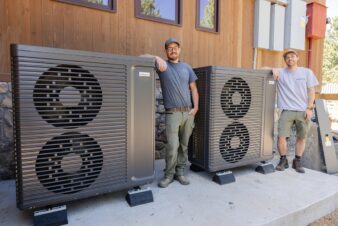
Why closely spaced tees?
Primary-secondary piping systems call for the tees that go off to the secondary circuit to be close together, ideally not more than six inches apart. Think like water and you’ll see why this is. Flow down the primary main and imagine you’re entering that first tee. You have two choices: You can stay in the primary loop and travel along the run of the tee, then six more inches before you enter the tee that’s returning the water from the secondary. That’s easy. Or you can enter the bull of that first tee, go all the way through the secondary circuit, and then come splashing back out through the bull of the return tee to enter the primary flow. Hey, that’s hard work! You’re not going to do that unless the secondary pump comes on. And that’s why we keep those tees so close together.
Grocery store radiant
A great place to understand radiant heating (or to explain it to your customer) is your local grocery store. Stop first in the gadget aisle and pick up a thermometer. It will probably read 70 degrees, a nice comfortable temperature. Walk up and down the aisles and keep your eye on the temperature. It never changes. No go into the frozen food aisle. Feel the chill? Check the thermometer. It’s still 70 degrees. What you’re feeling is a phenomenon known as Cold 70. It’s the feeling you get when the air temperature is 70 degrees but cold objects surround you. Your body gives off radiant heat to the cold surfaces and you feel cold. When you install radiant floors, walls or ceilings, you remove the cold surfaces and feel deliciously warm. Now go take your customer to the deli counter and stand in front of that chicken rotisserie. Just the opposite!
Watch the tailpipe
Start your car on a cold morning and walk around to the tailpipe. See that water dripping? That’s the way a high-efficiency, condensing boiler works. It removes so much of the heat from the flue gases that the gases turn to liquid and drip out. That liquid is acidic so we use neutralizers to deal with it before we dump it down the drain. Your car isn’t a condensing boiler, so it has a thermostat to keep the heater from heating the inside of your car until the engine comes up to a certain temperature. That’s to keep the acid out of your car’s muffler and tailpipe (Hey, repairs are expensive!). The next time your kids are yelling that they’re cold, and for you to turn on the heat, explain how a car is like a high-efficiency, condensing boiler. They’ll love you for that.
Radiator colors
Ever wonder why so many of the old radiators you see are painted silver? Back in the day, they were mostly plain grey metal, but then the Spanish Influenza arrived during the winter of 1918-19 and that changed everything. So many people died from this airborne virus that the Board of Health came out with a rule that we had to keep our windows open to prevent disease. Open-window ventilation led to huge radiators. When the Great Depression arrived, folks looked for ways to tone down those oversized radiators. Paint that contained flakes of metal (aluminum or bronze) had a way of cutting a radiator’s output by 20 percent so they started painting radiators that distinctive silver color. Funny thing is if you add a coat of ordinary paint on top of this, the radiator’s output goes right back to what it was. It’s true!
Where there is air
Air is the enemy in a hydronic (hot-water) heating system; it blocks the flow to the radiators. It rattles around and annoys customers. It wastes fuel by making our systems less efficient (no heat from an air-bound radiator). It causes callbacks and it makes us look bad. That’s why every hydronic system needs a good air separator. I think the best spot for this device is on the supply of the boiler. That’s where the water is hottest, and hot water has a tough time holding air. Any air separator, properly installed, will eventually get rid of the air. I like the microbubble air separators because they do a brilliant job of getting rid of the tiniest bubbles quickly. Ever draw water from a tap into a glass and then gag because they water looks milky white? Those are microbubbles. Let the water settle for a while and it will get clear.




Join the conversation: